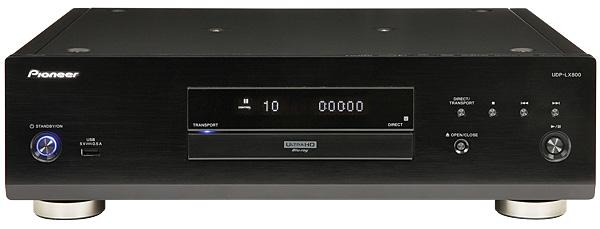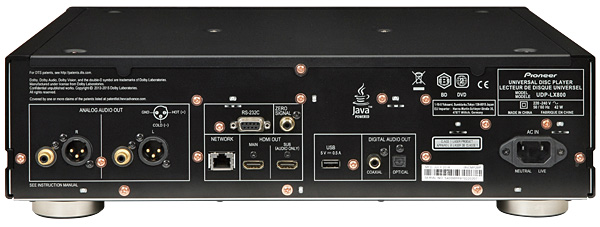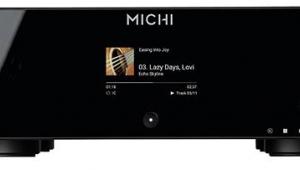Pioneer UDP-LX800 Universal BD Player

 Designed for movies as well as music, the idea of a 'universal' disc player is an appealing one. Now that Oppo is out of the picture, how does this battleship Pioneer shape up?
Designed for movies as well as music, the idea of a 'universal' disc player is an appealing one. Now that Oppo is out of the picture, how does this battleship Pioneer shape up?
Though maybe not for the hi-fi purists, who will look with disdain at any machine in which ultra-high-frequency video circuits are buzzing away, potentially affecting audio purity, for the pragmatist the concept of a 'universal' disc player is very appealing. In one machine you can have both a piece of hardware capable of playing both CDs and SACDs – and more – and a high-quality video source for a home cinema system.
Of course the idea of a do-it-all player is nothing new: we've had them since Blu-ray appeared, and they brought with them the bonus of being able to play hi-res audio as well as those newfangled discs. And, of course, the late lamented Oppo Digital built its reputation on high quality video/audio players. But Pioneer's new UDP-LX800, selling for a relatively punchy £2200, is about as universal as they come.
Not only does it play the latest UHD Blu-ray titles – and of course standard Blu-ray and DVD titles – but also DVD in all its flavours, from commercial video discs to recordable media, CDs and CD-R/RWs, and SACDs, too. It can also play content from USB media (pen drives and HDDs) plugged into either of the two USB Type A ports provided – one front, one rear. Moreover, its Ethernet port allows it to stream audio and video content stored on the home network, for example on a computer or a dedicated NAS unit.
A Confession
Before proceeding further, something of a confession: although I used to write about both audio and video systems in a previous life, and indeed still have a pretty good Blu-ray player, AV receiver and large-screen TV, I'm finding it hard to remember the last time I actually sat down and watched a movie. So those readers who want to discover if, and how, the 'LX800 cuts the filmic mustard should turn to our boxout written by HT expert, Steve May.
But back to HFN's core subject: the highest quality hi-fi. The UDP-LX800 certainly seems to have the wherewithal to compete in this ballpark, offering both conventional RCA and balanced XLR outputs, while playback from USB media and network sources goes right up to 192kHz/24-bit and DSD128/5.6MHz, both in stereo and 5.1-channel surround. Incidentally, playing surround audio is achieved via the HDMI output, the analogue outs being stereo only, so you'll need to factor in the cost of a multichannel processor or DAC if you want to take advantage of audio-only surround.
But if you have a surround set-up, as I do, then you'll quite possibly already have an AV receiver able to accept audio from the 'LX800 over HDMI. This is how I hooked up the player for surround duty, with connections for two-channel listening direct to my main hi-fi system from the player's analogue outs.

The UDP-LX800 has two HDMI outputs: a main one carrying both audio and video, designed for connecting to the TV, and a second only carrying audio. It's also worth noting that if you use a compatible Pioneer AV receiver, the company's PQLS (Precision Quartz Lock System) technology comes into play, essentially slaving the player's master clock to that in the receiver over the HDMI link, for lower jitter. This system alters its operation to suit the signal being sent, with separate modes for two-channel music from CD, multichannel from Blu-ray, or a bitstream, for example from SACDs.
On-Screen Menu
One disadvantage of combined AV players is that much of the set-up navigation and operation relies on on-screen information and feedback. For example, the UDP-LX800 has switchable digital filters, accessed via a button on the remote control, but best viewed as part of its 'Audio Parameters' on-screen menu. For those not wanting, or unable to use the player with a full-size screen, it's possible to add a compact monitor, which will set you back less than £100 from that site named after a South American river.
The filters, incidentally, are described as 'Sharp', 'Short' and 'Slow', and are applicable only to the analogue outputs. However, when the player is used in its 'Direct' or 'Transport' modes, the former of which switches off the video and digital outputs for the purest possible sound, these settings aren't available. I have to say that I found the 'Short' and 'Slow' settings a little too soft and lazy – especially the latter – and opted for the traditional 'Sharp' (roll-off) linear phase filter as my default.
Hidden Touches
As our inside view shows, the 'LX800 may be a multifunctional machine, but its design and build is both modular and compartmentalised. The circuitry is split into three blocks – power supply, analogue audio and everything else – with the transport mechanism floated to minimise vibration ingress, mounted in an enclosure stamped into a honeycomb pattern for greater rigidity and with further damping for the disc-tray. The whole player is built for solidity and rigidity, with a hefty 3mm steel plate under the 1.6mm-thick chassis to reinforce things and lower the centre of gravity, while the casework is solid metal with alloy side panels, and no vents to weaken the structure.
























































